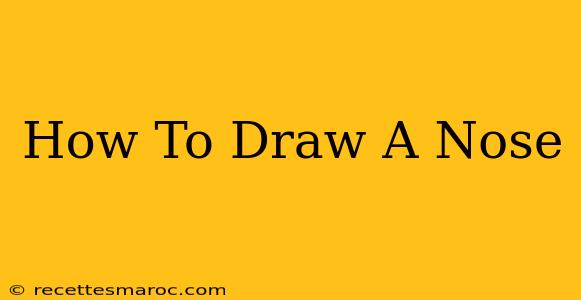Drawing a nose can seem daunting, but with the right techniques and a little practice, you can master this fundamental facial feature. This guide will walk you through various methods, from simple cartoon noses to more realistic representations, catering to artists of all skill levels. Whether you're a complete beginner picking up a pencil for the first time or an experienced artist looking to refine your skills, you'll find valuable tips and tricks here.
Understanding Nose Anatomy: The Foundation of Realistic Drawing
Before diving into the drawing process, it's crucial to understand the basic anatomy of a nose. This knowledge will enable you to create more believable and lifelike representations. A nose is essentially comprised of:
- Bridge: The upper part of the nose, connecting to the forehead.
- Nasal Bone: The bony structure that forms the bridge.
- Cartilage: The flexible tissue that shapes the lower part of the nose.
- Nostrils: The two openings at the bottom of the nose.
- Tip: The very end of the nose.
- Wings: The fleshy sides of the nostrils.
Observing Different Nose Shapes
Noses come in a vast array of shapes and sizes. Observing real-life noses – either from photographs or directly from life – is essential for capturing their unique characteristics. Pay attention to:
- Width: Is the nose narrow, wide, or somewhere in between?
- Length: Is it long, short, or average?
- Bridge: Is the bridge straight, curved, or hooked?
- Tip: Is the tip rounded, pointed, upturned, or downturned?
- Nostrils: Are the nostrils round, oval, or flared?
Simple Methods: Drawing Cartoon Noses
For beginners or those working on simpler styles, a cartoon nose offers a great starting point. Here are a few easy methods:
The "Simple Line" Nose
- Draw a simple vertical line.
- Add two small circles or ovals at the bottom for nostrils.
- You're done! This is a great foundation for character design.
The "Triangle" Nose
- Draw a small triangle.
- Add a curved line at the base to represent the nostrils.
- This method is quick and still conveys the shape of a nose.
More Realistic Approaches: Mastering the Details
To draw a more realistic nose, we'll employ a step-by-step process that incorporates the anatomical features we discussed earlier.
Step-by-Step Guide to a Realistic Nose
- Start with the Bridge: Lightly sketch the bridge of the nose using a curved line. The curve will depend on the type of nose you are drawing.
- Define the Sides: Draw two slightly curved lines extending downwards from the bridge, defining the sides of the nose.
- Shape the Tip: Connect the bottom ends of the side lines, creating the tip of the nose. The shape of this connection is crucial for achieving realism.
- Add the Nostrils: Sketch the nostrils. Pay close attention to their shape and size in relation to the rest of the nose. They're often not perfectly symmetrical.
- Refine the Details: Once you have the basic shape, refine the lines and add shadows to enhance the three-dimensionality of the nose.
- Add Shadows and Highlights: Use shading to create depth and volume. Observe where the light hits the nose and add highlights accordingly.
Tips and Tricks for Mastering Nose Drawing
- Practice Regularly: The more you practice, the better you'll become.
- Use Reference Images: Don't be afraid to use photos as references.
- Experiment with Different Media: Try pencils, charcoal, or even digital tools.
- Focus on Values: Understanding light and shadow is key to creating a realistic nose.
- Break It Down into Shapes: Simplify complex shapes into basic geometric forms.
Conclusion: Your Journey to Realistic Nose Drawing
Drawing a realistic nose is a journey, not a destination. Through practice, observation, and a commitment to understanding the underlying anatomy, you'll continually improve your skills. Don't be discouraged by initial challenges— keep practicing, and you'll soon find yourself confidently capturing the nuances of this essential facial feature. Happy drawing!

